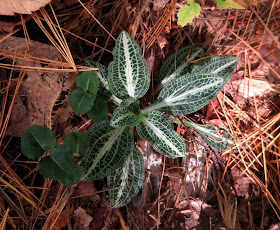I hardly ever get to walk with my fellow nature-loving pal Sue, since she started working days instead of evenings. We try to get together on weekends, though, and we were lucky this past Sunday when the rain stopped by early afternoon, giving us time for a pleasant walk in Cole's Woods in downtown Glens Falls.
It's amazing to find such an extensive woodland in the middle of a city, and even though we can still hear traffic sounds as we wander the complex network of trails within this many-acred woods, it feels like we're deeply immersed in nature back here. Especially when we keep to the trails that follow the pretty brook at the center of the woods.
Sue and I visit Cole's Woods several times during the wildflower season, so we have become familiar with where certain flowers grow. Even now, with most of the flowers long spent, we enjoy revisiting their locations, seeking out the flowers' remnants and always hoping to discover new patches of favorite finds. We did find a new patch of Pyrolas on Sunday, both the common Shinleaf Pyrola (Pyrola elliptica) with its larger rounded leaves, and also the One-sided Pyrola (Orthilia secunda) with its smaller, more pointed leaves. This photo shows the two different species side-by-side amid the small evergreen leaves of Partridgeberry (Mitchella repens).
Our identifications of the different species were confirmed when we found many flower stalks, now containing their seeds. Here I am holding a stalk of One-sided Pyrola with its dangling seed pods.
Along with the Pyrolas, many other of our favorite summer flowers bear evergreen leaves, making them easy to find any time of the year. This photo shows the glossy green leaves of Pipsissiwa (Chimaphila umbellata) next to a berry-bearing sprig of Partridgeberry.
An unexpected find was this lovely Downy Rattlesnake Plantain (Goodyera pubescens) with its gorgeously patterned evergreen leaves. We had never found this little native orchid in Cole's Woods before.
In the damp soil along the brook we found many patches of different mosses, which will also stay green all winter. We also found many shoots of Skunk Cabbage (Symplocarpus foetidus), which will overwinter with its pale bluish-green spathes tightly furled until early spring. This Skunk Cabbage shoot has pushed up between mounds of Delicate Fern Moss (Thuidium delicatulum) and Rose Moss (Rhodobryum ontariense).
I hope visitors to Cole's Woods are not tempted to pick a bough of these beautifully colored leaves, since these are the leaves of Poison Sumac (Toxicodendron vernix). They were among the most vividly colored leaves we found this day, and although they were growing in swampy spots few hikers would venture into, some of the shrubs did grow within arm's reach of the nearby trails.
When I first noticed this plump and colorful Marbled Orb Weaver spider on the ground, I thought it was a yellow gall that had fallen from a tree, and I picked it up to examine it more closely. Oops! Sorry, little lady! I didn't mean to frighten you. (Or me!)
I'm not really afraid of spiders, but I was quite surprised when the "gall" started to wriggle and tickle my hand with those tiger-striped legs. I was also impressed by the size and plumpness of this spider's abdomen. I have seen this species of spider many times before, but their abdomens were always more slender and with black markings, instead of these reddish traceries. Those must have been males. The large size and round shape of this abdomen indicate that this is a female. Perhaps that bulbous abdomen is full of eggs.
Here's another photo of this spider, and I placed my finger next to her to show how big and fat she was:










Remarkable woods to be inside a city! I've never looked for Skunk Cabbage in the fall, may have to just check that out.
ReplyDelete